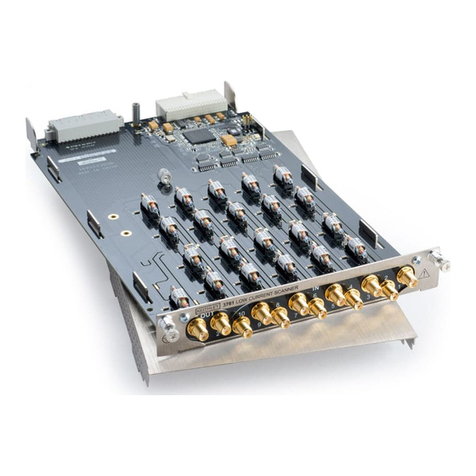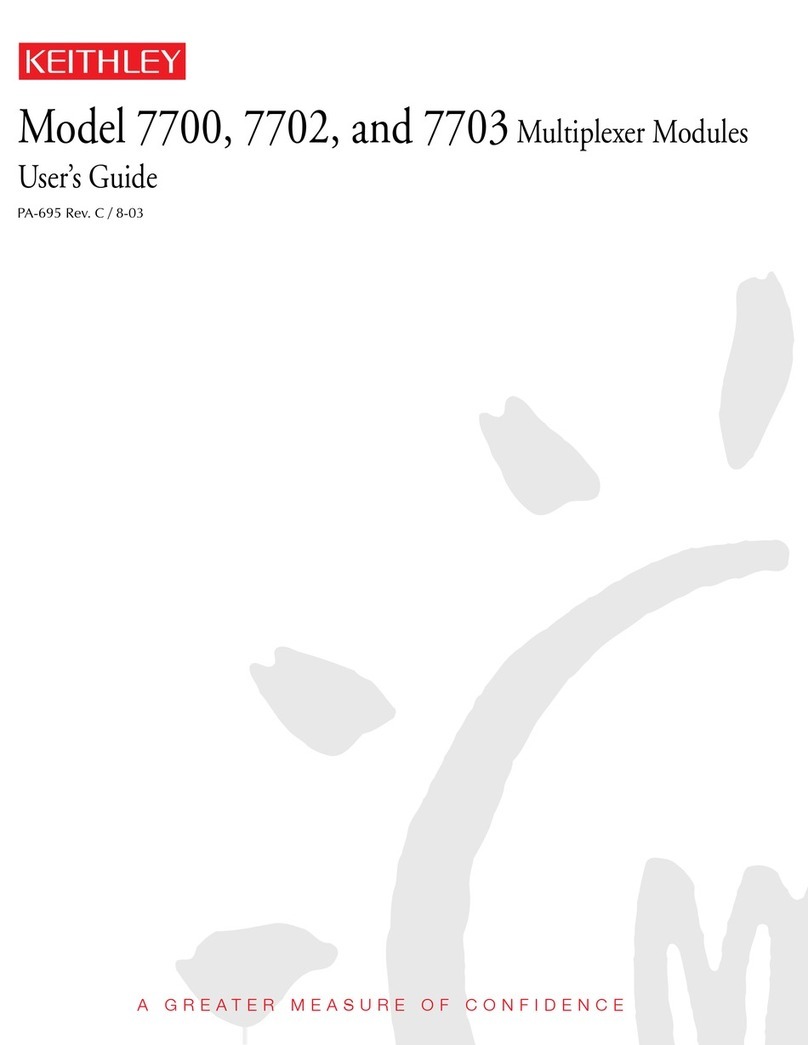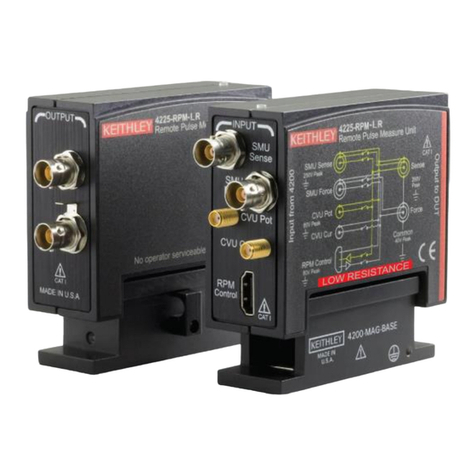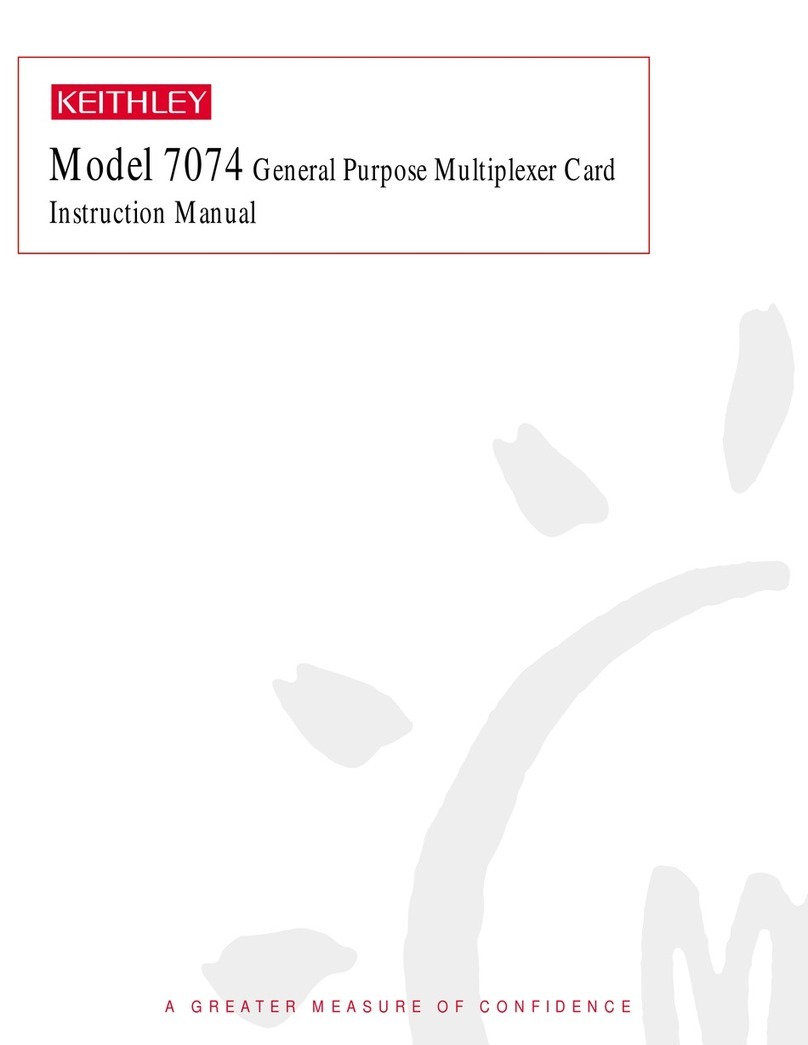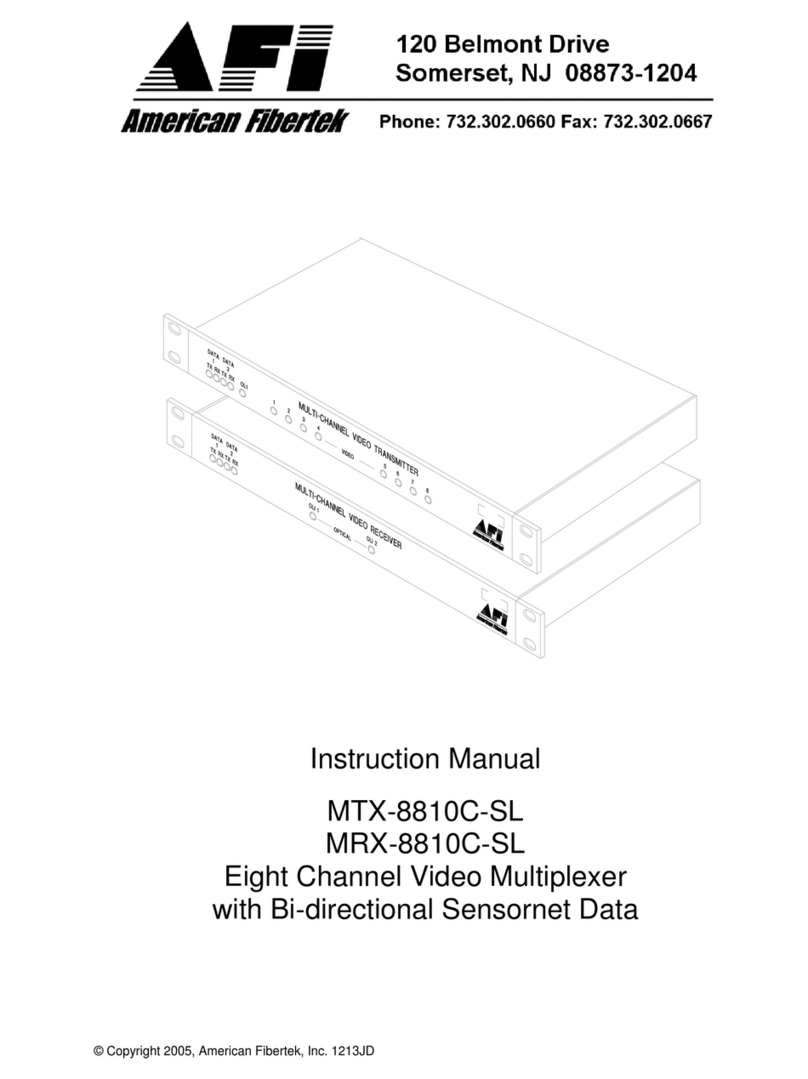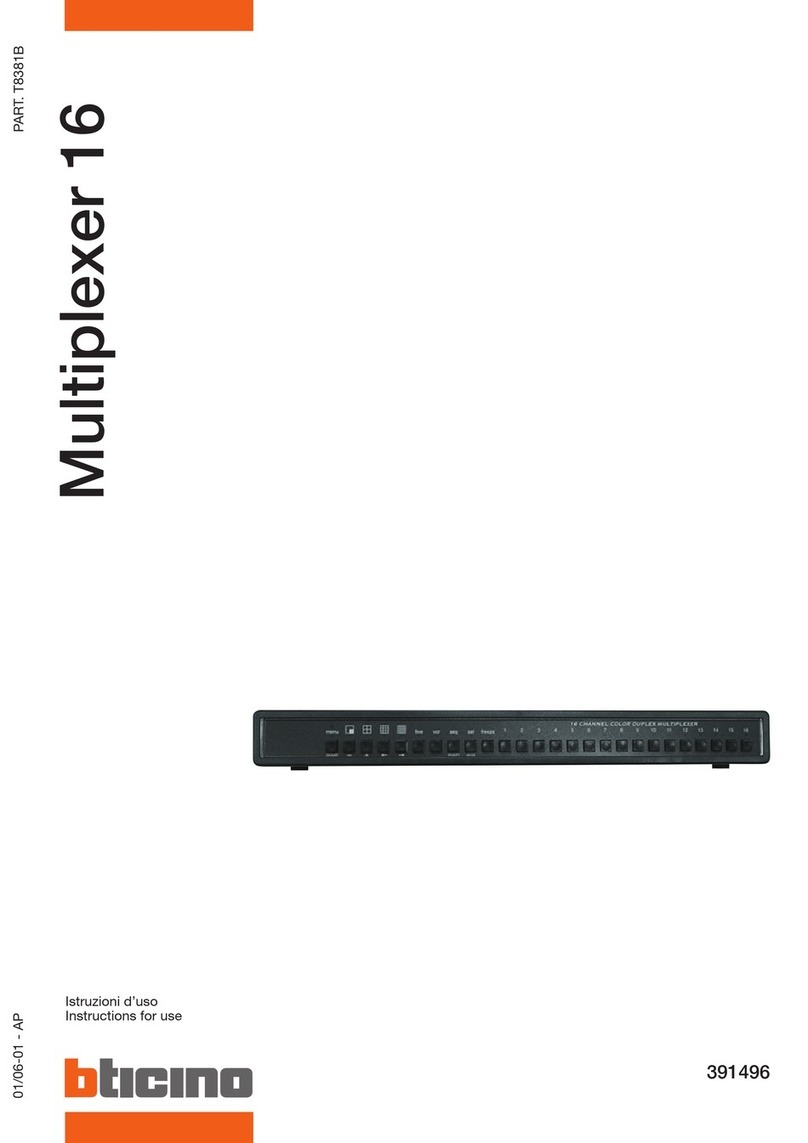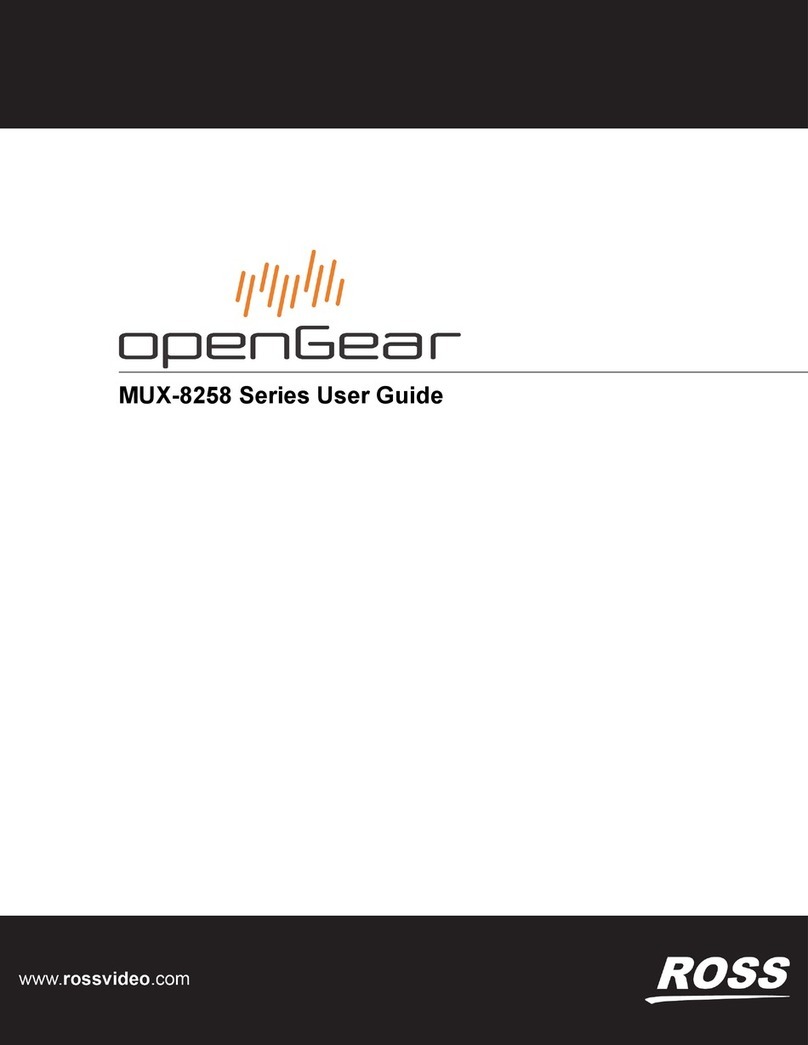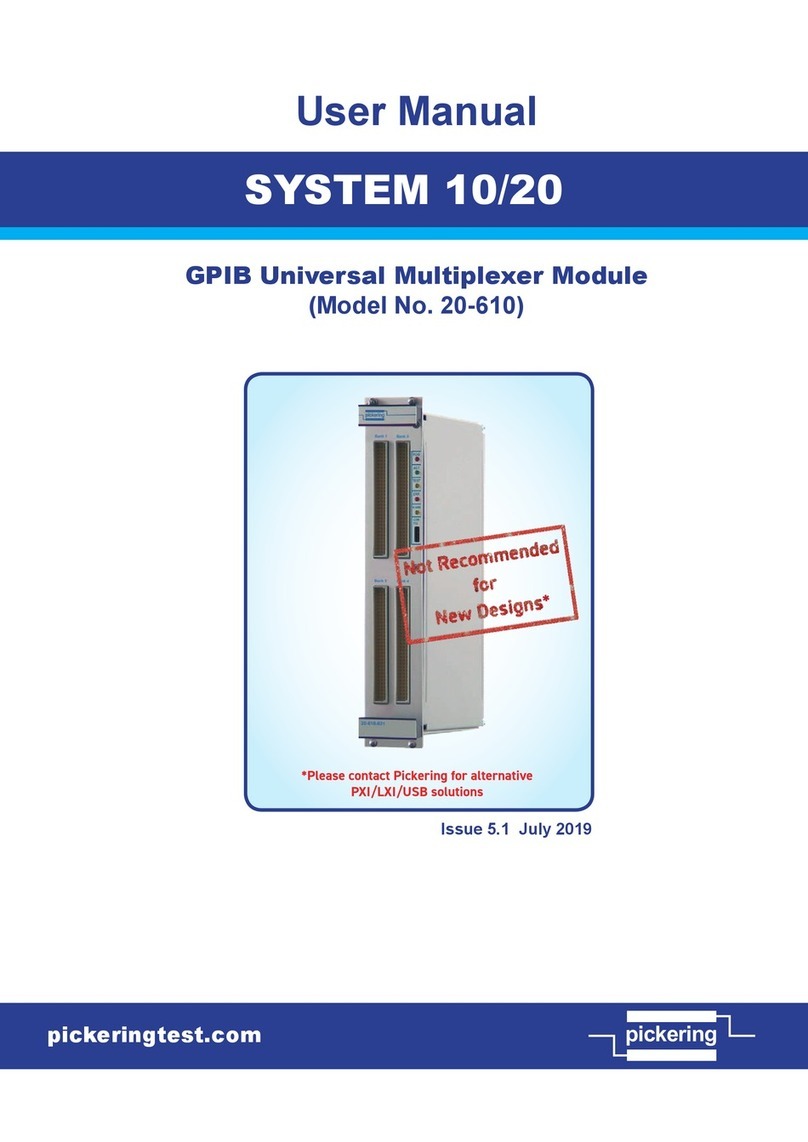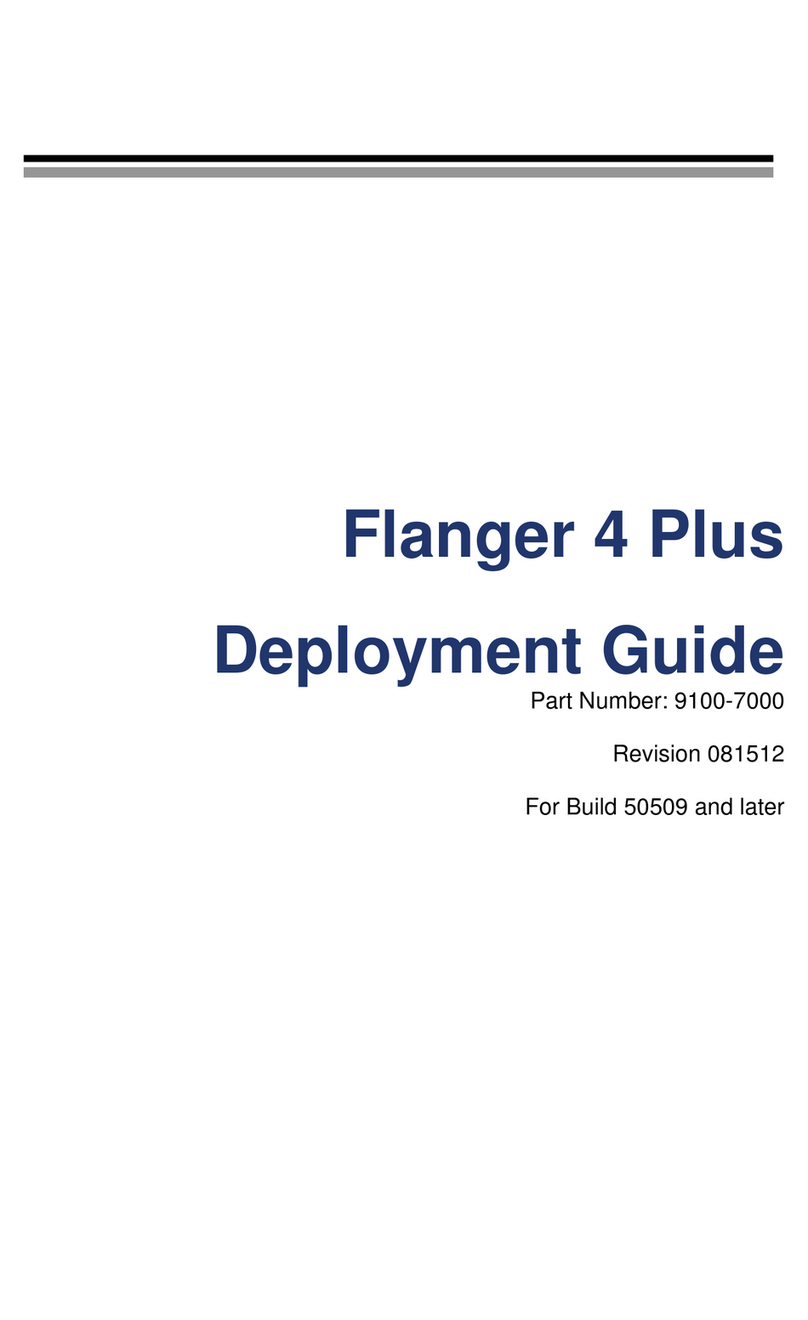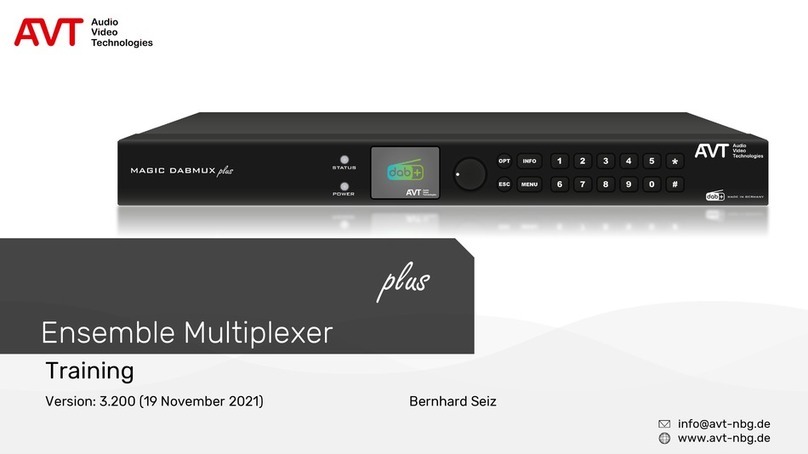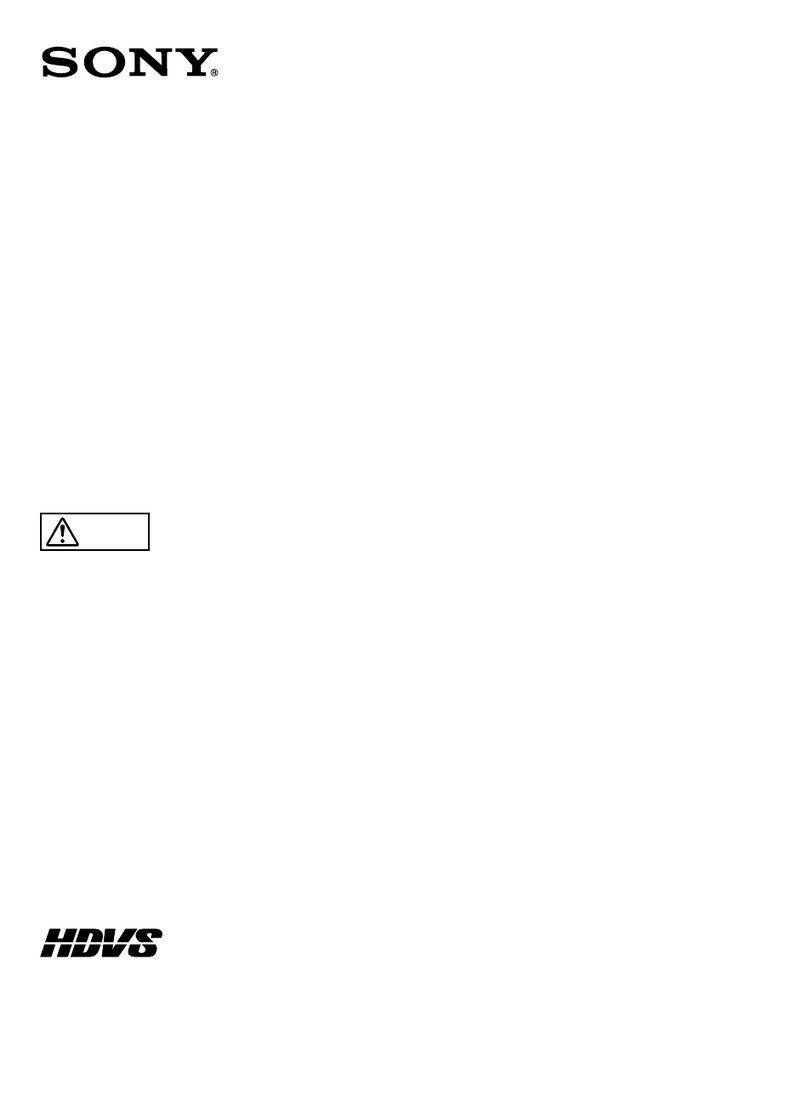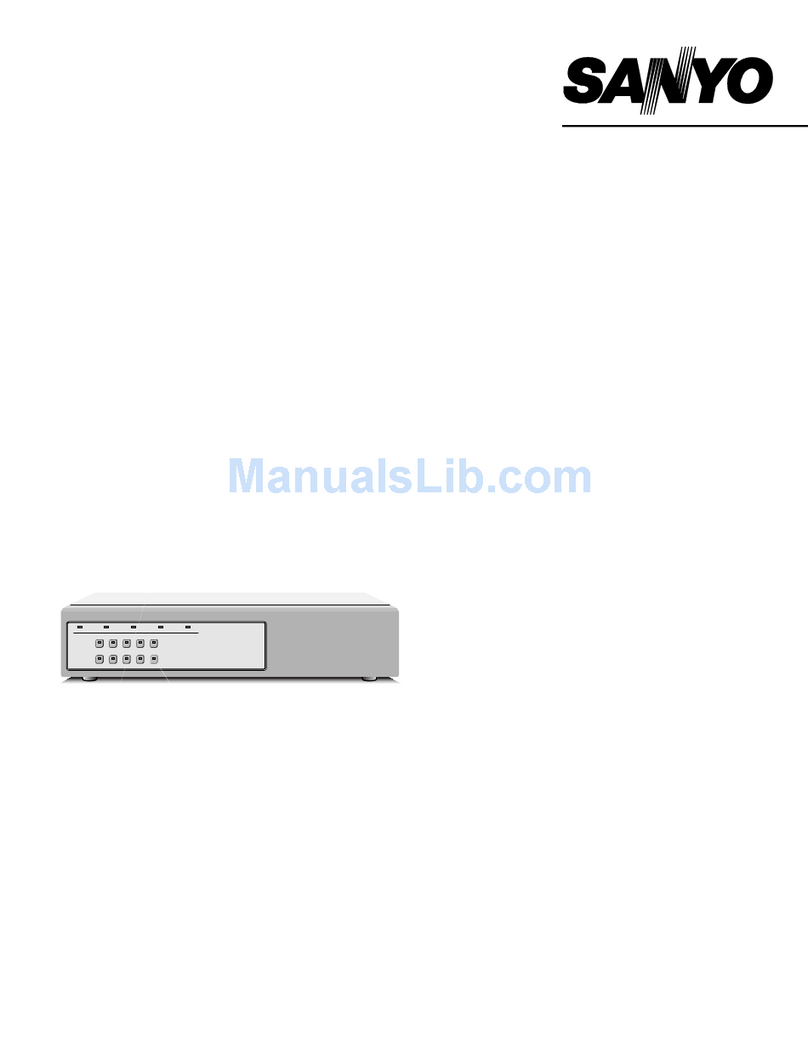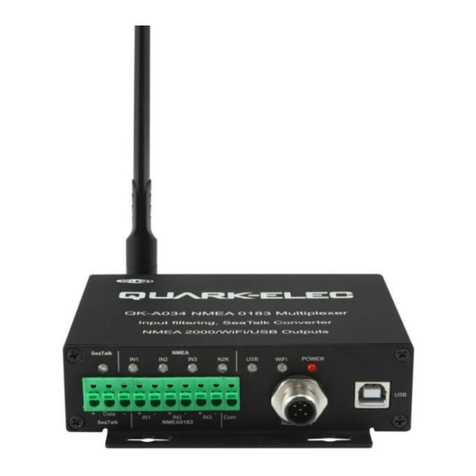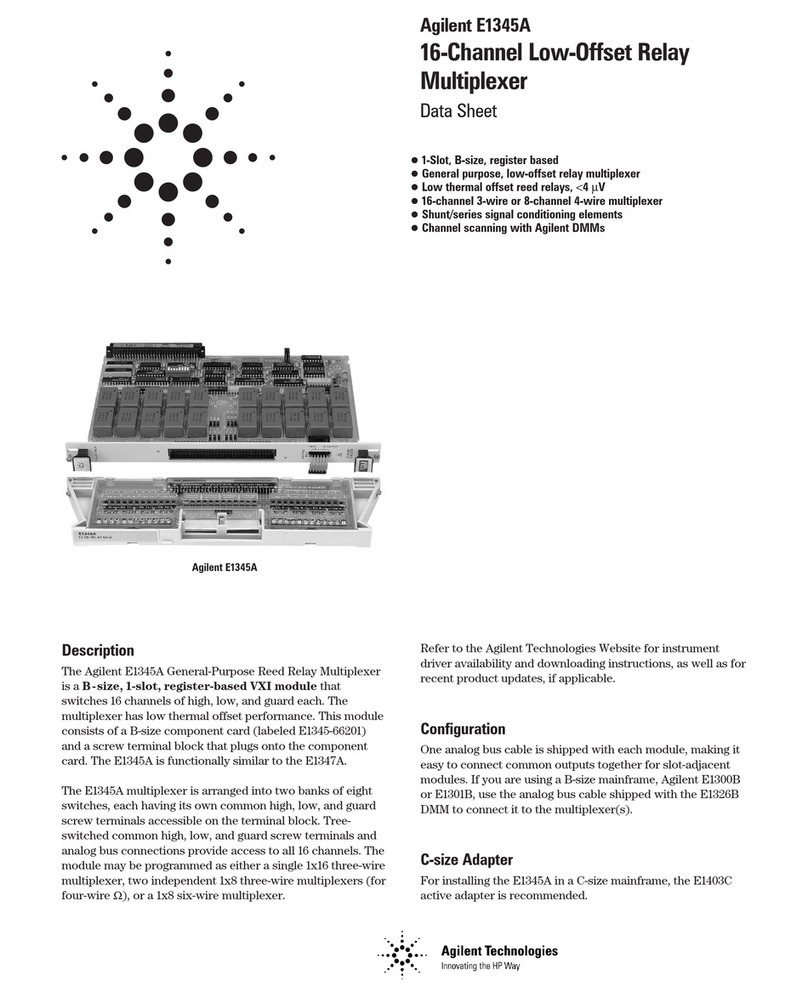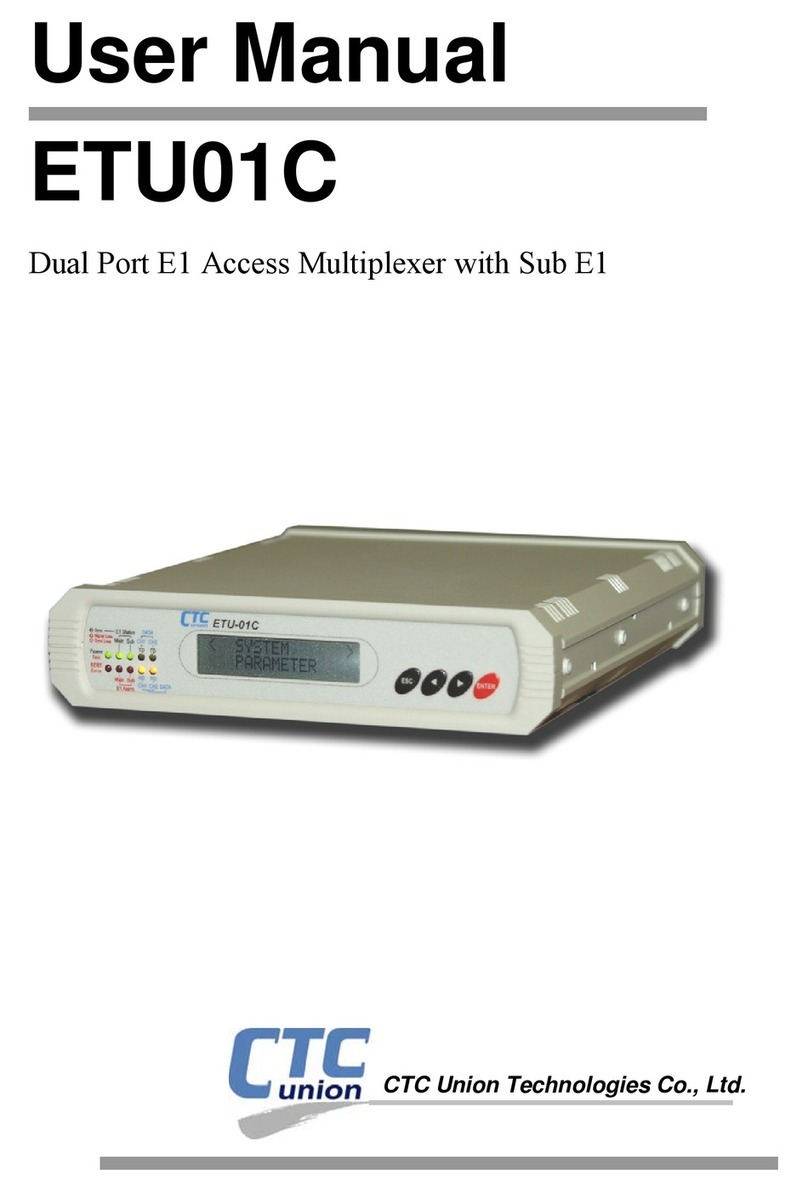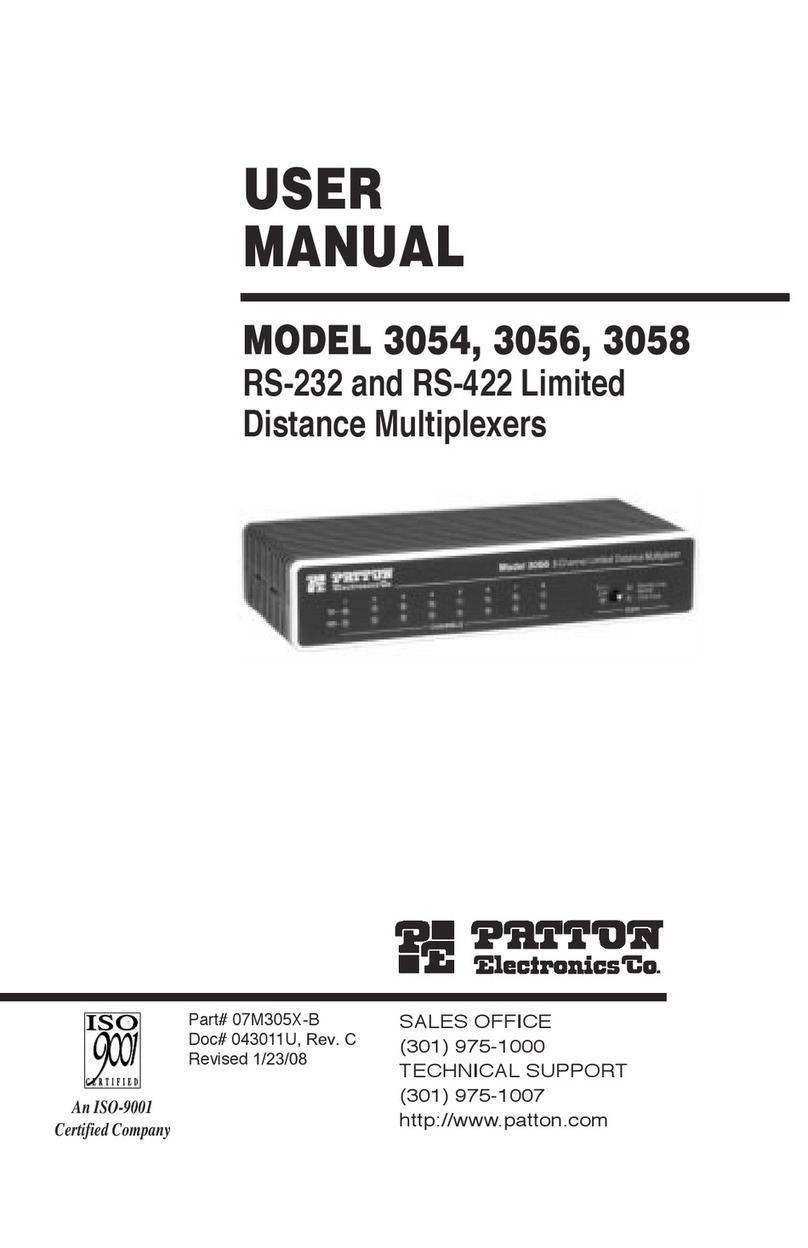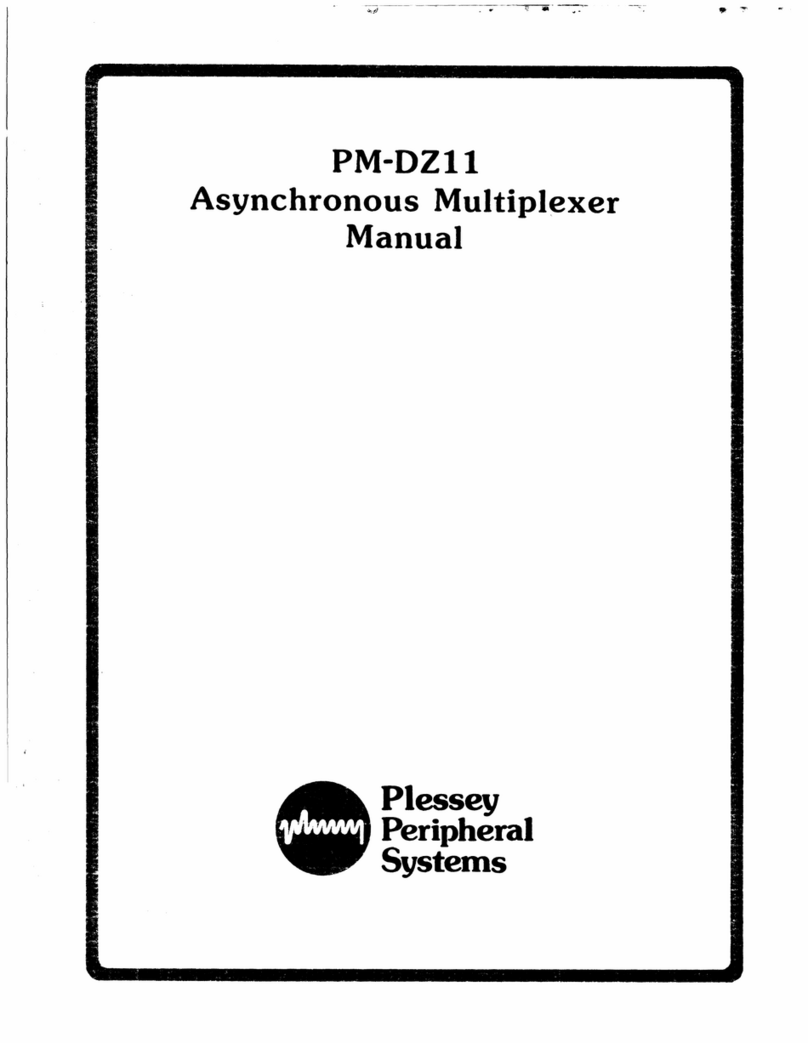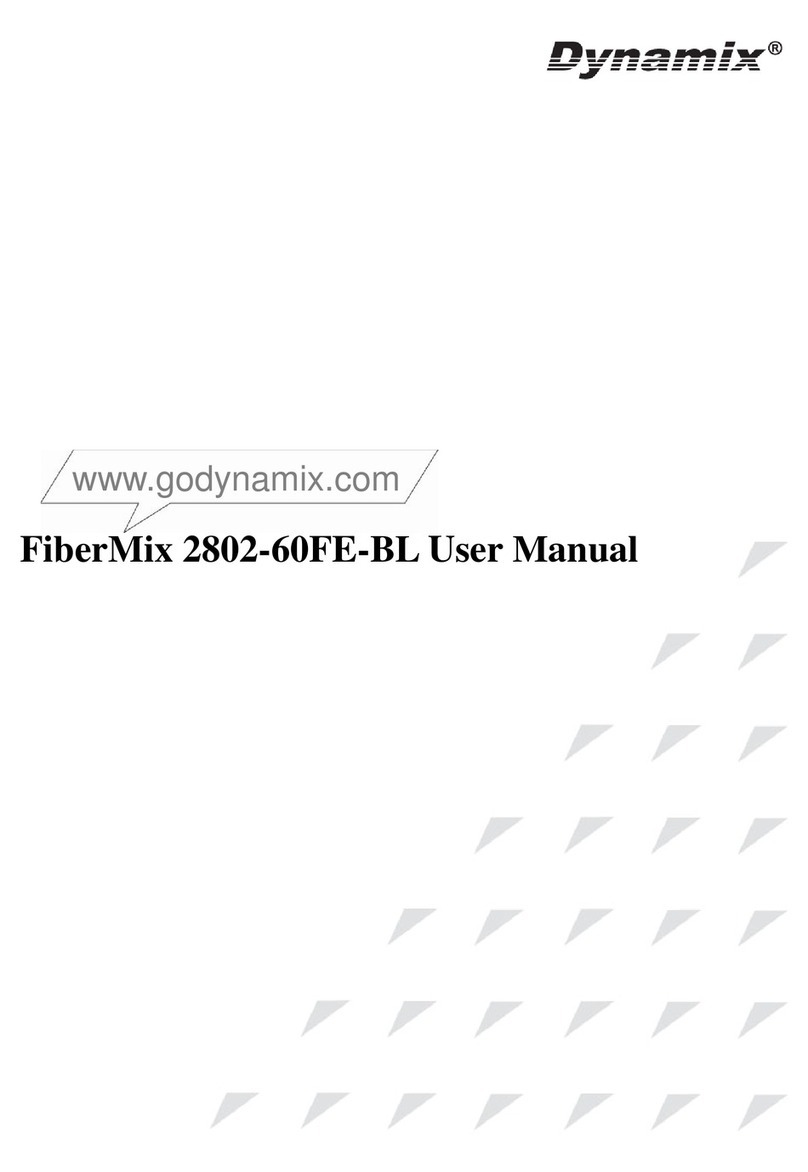Keithley 7706 User manual

Model 7706 Multiplexer Card
User’s Guide
PA-719 Rev. C / 2-00
A GREATER MEASURE OF CONFIDENCE
The Model 7706 can be used with Keithley
Models 2700, 2701, and 2750. All references
to the Model 2700 also apply to the Models
2701 and 2750.

WARRANTY
Keithley Instruments, Inc. warrants this product to be free from defects in material and workmanship for a period of 1 year
from date of shipment.
Keithley Instruments, Inc. warrants the following items for 90 days from the date of shipment: probes, cables, rechargeable
batteries, diskettes, and documentation.
During the warranty period, we will, at our option, either repair or replace any product that proves to be defective.
To exercise this warranty, write or call your local Keithley representative, or contact Keithley headquarters in Cleveland, Ohio.
You will be given prompt assistance and return instructions. Send the product, transportation prepaid, to the indicated service
facility. Repairs will be made and the product returned, transportation prepaid. Repaired or replaced products are warranted for
the balance of the original warranty period, or at least 90 days.
LIMITATION OF WARRANTY
This warranty does not apply to defects resulting from product modification without Keithley’s express written consent, or
misuse of any product or part. This warranty also does not apply to fuses, software, non-rechargeable batteries, damage from
battery leakage, or problems arising from normal wear or failure to follow instructions.
THIS WARRANTY IS IN LIEU OF ALL OTHER WARRANTIES, EXPRESSED OR IMPLIED, INCLUDING ANY
IMPLIED WARRANTY OF MERCHANTABILITY OR FITNESS FOR A PARTICULAR USE. THE REMEDIES PRO-
VIDED HEREIN ARE BUYER’S SOLE AND EXCLUSIVE REMEDIES.
NEITHER KEITHLEY INSTRUMENTS, INC. NOR ANY OF ITS EMPLOYEES SHALL BE LIABLE FOR ANY DIRECT,
INDIRECT, SPECIAL, INCIDENTAL OR CONSEQUENTIAL DAMAGES ARISING OUT OF THE USE OF ITS
INSTRUMENTS AND SOFTWARE EVEN IF KEITHLEY INSTRUMENTS, INC., HAS BEEN ADVISED IN ADVANCE
OF THE POSSIBILITY OF SUCH DAMAGES. SUCH EXCLUDED DAMAGES SHALL INCLUDE, BUT ARE NOT LIM-
ITED TO: COSTS OF REMOVAL AND INSTALLATION, LOSSES SUSTAINED AS THE RESULT OF INJURY TO ANY
PERSON, OR DAMAGE TO PROPERTY.
Keithley Instruments, Inc.
28775 Aurora Road • Cleveland, Ohio 44139 • 440-248-0400 • Fax: 440-248-6168
1-888-KEITHLEY (534-8453) • www.keithley.com
Sales Offices:BELGIUM: Bergensesteenweg 709 • B-1600 Sint-Pieters-Leeuw • 02-363 00 40 • Fax: 02/363 00 64
CHINA: Yuan Chen Xin Building, Room 705 • 12 Yumin Road, Dewai, Madian • Beijing 100029 • 8610-6202-2886 • Fax: 8610-6202-2892
FINLAND: Tietäjäntie 2 • 02130 Espoo • Phone: 09-54 75 08 10 • Fax: 09-25 10 51 00
FRANCE: 3, allée des Garays • 91127 Palaiseau Cédex • 01-64 53 20 20 • Fax: 01-60 11 77 26
GERMANY: Landsberger Strasse 65 • 82110 Germering • 089/84 93 07-40 • Fax: 089/84 93 07-34
GREAT BRITAIN: Unit 2 Commerce Park, Brunel Road • Theale • Berkshire RG7 4AB • 0118 929 7500 • Fax: 0118 929 7519
INDIA: Flat 2B, Willocrissa • 14, Rest House Crescent • Bangalore 560 001 • 91-80-509-1320/21 • Fax: 91-80-509-1322
ITALY: Viale San Gimignano, 38 • 20146 Milano • 02-48 39 16 01 • Fax: 02-48 30 22 74
JAPAN: New Pier Takeshiba North Tower 13F • 11-1, Kaigan 1-chome • Minato-ku, Tokyo 105-0022 • 81-3-5733-7555 • Fax: 81-3-5733-7556
KOREA: 2FL., URI Building • 2-14 Yangjae-Dong • Seocho-Gu, Seoul 137-888 • 82-2-574-7778 • Fax: 82-2-574-7838
NETHERLANDS: Postbus 559 • 4200 AN Gorinchem • 0183-635333 • Fax: 0183-630821
SWEDEN: c/o Regus Business Centre • Frosundaviks Allé 15, 4tr • 169 70 Solna • 08-509 04 679 • Fax: 08-655 26 10
SWITZERLAND: Kriesbachstrasse 4 • 8600 Dübendorf • 01-821 94 44 • Fax: 01-820 30 81
TAIWAN: 1FL., 85 Po Ai Street • Hsinchu, Taiwan, R.O.C. • 886-3-572-9077• Fax: 886-3-572-9031
4/02

Safety Precautions
The following safety precautions should be observed before using
this product and any associated instrumentation. Although some in-
struments and accessories would normally be used with non-haz-
ardous voltages, there are situations where hazardous conditions
may be present.
This product is intended for use by qualified personnel who recog-
nize shock hazards and are familiar with the safety precautions re-
quired to avoid possible injury. Read and follow all installation,
operation, and maintenance information carefully before using the
product. Refer to the manual for complete product specifications.
If the product is used in a manner not specified, the protection pro-
vided by the product may be impaired.
The types of product users are:
Responsible body
is the individual or group responsible for the use
and maintenance of equipment, for ensuring that the equipment is
operated within its specifications and operating limits, and for en-
suring that operators are adequately trained.
Operators
use the product for its intended function. They must be
trained in electrical safety procedures and proper use of the instru-
ment. They must be protected from electric shock and contact with
hazardous live circuits.
Maintenance personnel
perform routine procedures on the product
to keep it operating properly, for example, setting the line voltage
or replacing consumable materials. Maintenance procedures are de-
scribed in the manual. The procedures explicitly state if the operator
may perform them. Otherwise, they should be performed only by
service personnel.
Service personnel
are trained to work on live circuits, and perform
safe installations and repairs of products. Only properly trained ser-
vice personnel may perform installation and service procedures.
Keithley products are designed for use with electrical signals that
are rated Installation Category I and Installation Category II, as de-
scribed in the International Electrotechnical Commission (IEC)
Standard IEC 60664. Most measurement, control, and data I/O sig-
nals are Installation Category I and must not be directly connected
to mains voltage or to voltage sources with high transient over-volt-
ages. Installation Category II connections require protection for
high transient over-voltages often associated with local AC mains
connections. Assume all measurement, control, and data I/O con-
nections are for connection to Category I sources unless otherwise
marked or described in the Manual.
Exercise extreme caution when a shock hazard is present. Lethal
voltage may be present on cable connector jacks or test fixtures. The
American National Standards Institute (ANSI) states that a shock
hazard exists when voltage levels greater than 30V RMS, 42.4V
peak, or 60VDC are present.
A good safety practice is to expect
that hazardous voltage is present in any unknown circuit before
measuring.
Operators of this product must be protected from electric shock at
all times. The responsible body must ensure that operators are pre-
vented access and/or insulated from every connection point. In
some cases, connections must be exposed to potential human con-
tact. Product operators in these circumstances must be trained to
protect themselves from the risk of electric shock. If the circuit is
capable of operating at or above 1000 volts,
no conductive part of
the circuit may be exposed.
Do not connect switching cards directly to unlimited power circuits.
They are intended to be used with impedance limited sources.
NEVER connect switching cards directly to AC mains. When con-
necting sources to switching cards, install protective devices to lim-
it fault current and voltage to the card.
Before operating an instrument, make sure the line cord is connect-
ed to a properly grounded power receptacle. Inspect the connecting
cables, test leads, and jumpers for possible wear, cracks, or breaks
before each use.
When installing equipment where access to the main power cord is
restricted, such as rack mounting, a separate main input power dis-
connect device must be provided, in close proximity to the equip-
ment and within easy reach of the operator.
For maximum safety, do not touch the product, test cables, or any
other instruments while power is applied to the circuit under test.
ALWAYS remove power from the entire test system and discharge
any capacitors before: connecting or disconnecting cables or jump-
ers, installing or removing switching cards, or making internal
changes, such as installing or removing jumpers.
Do not touch any object that could provide a current path to the com-
mon side of the circuit under test or power line (earth) ground.Always
make measurements with dry hands while standing on a dry, insulated
surface capable of withstanding the voltage being measured.
The instrument and accessories must be used in accordance with its
specifications and operating instructions or the safety of the equip-
ment may be impaired.
Do not exceed the maximum signal levels of the instruments and ac-
cessories, as defined in the specifications and operating informa-
tion, and as shown on the instrument or test fixture panels, or
switching card.
When fuses are used in a product, replace with same type and rating
for continued protection against fire hazard.
Chassis connections must only be used as shield connections for
measuring circuits, NOT as safety earth ground connections.
If you are using a test fixture, keep the lid closed while power is ap-
plied to the device under test. Safe operation requires the use of a
lid interlock.
5/02

If or is present, connect it to safety earth ground using the
wire recommended in the user documentation.
The symbol on an instrument indicates that the user should re-
fer to the operating instructions located in the manual.
The symbol on an instrument shows that it can source or mea-
sure 1000 volts or more, including the combined effect of normal
and common mode voltages. Use standard safety precautions to
avoid personal contact with these voltages.
The
WARNING
heading in a manual explains dangers that might
result in personal injury or death. Always read the associated infor-
mation very carefully before performing the indicated procedure.
The
CAUTION
heading in a manual explains hazards that could
damage the instrument. Such damage may invalidate the warranty.
Instrumentation and accessories shall not be connected to humans.
Before performing any maintenance, disconnect the line cord and
all test cables.
To maintain protection from electric shock and fire, replacement
components in mains circuits, including the power transformer, test
leads, and input jacks, must be purchased from Keithley Instru-
ments. Standard fuses, with applicable national safety approvals,
may be used if the rating and type are the same. Other components
that are not safety related may be purchased from other suppliers as
long as they are equivalent to the original component. (Note that se-
lected parts should be purchased only through Keithley Instruments
to maintain accuracy and functionality of the product.) If you are
unsure about the applicability of a replacement component, call a
Keithley Instruments office for information.
To clean an instrument, use a damp cloth or mild, water based
cleaner. Clean the exterior of the instrument only. Do not apply
cleaner directly to the instrument or allow liquids to enter or spill
on the instrument. Products that consist of a circuit board with no
case or chassis (e.g., data acquisition board for installation into a
computer) should never require cleaning if handled according to in-
structions. If the board becomes contaminated and operation is af-
fected, the board should be returned to the factory for proper
cleaning/servicing.
!

Model 7706 All-in-One module
Connection, operation, calibration, and parts information
Introduction
This packing sheet contains information specific to the Model 7706 module. If you have any questions after reviewing this in-
formation, please contact your local Keithley representative or call one of our Applications Engineers at 1-800-348-3735 (U.S.
and Canada only). This document is arranged as follows:
Description Page
Connection
Card configuration—schematic ............................................................................................................................................ 2
Card configuration—connections ......................................................................................................................................... 4
Wiring procedure .................................................................................................................................................................. 5
Typical connections (channels 1–20).................................................................................................................................... 7
Digital outputs (channels 21–22) .......................................................................................................................................... 9
Analog outputs (channels 23–24) ....................................................................................................................................... 15
Totalizer .............................................................................................................................................................................. 18
Totalizer channel monitor scan example............................................................................................................................. 22
Specifications ...................................................................................................................................................................... 24
Connection log.................................................................................................................................................................... 24
Front panel operation
Card specific menu.............................................................................................................................................................. 26
Bus commands
Sending channel numbers ................................................................................................................................................... 27
OUTPut Subsystem............................................................................................................................................................. 28
SENSe[1] Subsystem.......................................................................................................................................................... 29
Unsupported SCPI commands ............................................................................................................................................ 30
Verification
Analog outputs.................................................................................................................................................................... 30
Totalizer .............................................................................................................................................................................. 32
Calibration
Recommended test equipment ............................................................................................................................................ 34
Extender board connections................................................................................................................................................ 34
Front panel Model 7706 temperature calibration................................................................................................................ 34
Remote Model 7706 temperature calibration ..................................................................................................................... 35
Front panel Model 7706 analog output (DAC) calibration................................................................................................. 35
Remote Model 7706 analog output (DAC) calibration....................................................................................................... 36
Calibration commands ................................................................................................................................................................36
Remote error reporting................................................................................................................................................................42
Detecting calibration step completion.........................................................................................................................................44
Replaceable parts ........................................................................................................................................................................45
Specifications ..............................................................................................................................................................................50

2
Model 7706 module
Connection
The Model 7706 is a 20-channel differential multiplexer card with the following features:
• 20 channels of analog input with 300V, 1A capacity; 60W, 125VA maximum
• 16 channels of digital output for output control
• One event counter/Totalizer
• Two analog outputs (±12V @ 5mA with 16-bit programmability)
• 2-wire or 4-wire
Ω
measurement (automatically pairs switches for four wire measurements —
n
+ 10)
• Temperature applications (RTD, thermistor, thermocouple)
• Built-in automatic cold junction reference (CJC)
• Screw terminal connections
• Designed specifically for use with Keithley’s Model 2700 Multimeter/Data Acquisition System
Card configuration—schematic
Figure 1 shows a simplified schematic diagram of the Model 7706 module. As shown, the Model 7706 has channels that are
grouped into two banks of ten channels (twenty channels total). Backplane isolation is provided for each bank. Each bank also
includes separate cold junction reference points. The first bank contains channels 1 through 10 while the second bank contains
channels 11 through 20. Each channel of the 20-channel multiplexer card is wired with separate inputs for HI/LO providing
fully isolated inputs.
NOTE
Although the Model 7706 relays are the latching type (relays hold their state even after power has been
removed), all relay states are set to open a few seconds after either a power cycle or an *RST command is
issued.
Connections to DMM functions are provided through the card backplane connector for the following:
INPUT connections
SENSE (
Ω
4-Wire) connections
Channels 21–22 (digital output), 23–24 (analog output), and 25 (Totalizer) are controlled either over the bus or from the front
panel. The grounds for these channels are non-isolated. Detailed information on each channel is contained later in this section.
Channel 26 (2W/4W Configuration), Channel 27 (Sense Isolation), and Channel 28 (Input Isolation) are normally automatically
configured by the 2700. However, by using the
:ROUT:MULT:
commands (refer to Section 2 of the 2700 User’s Manual), they
can be manually configured.

3
Connection
Figure 1
Simplified schematic for Model 7706
NOTES
Connect 4-wire sense leads using channels 11–20.
To disconnect channels 11–20 from channels 1–10, send:
:ROUT:MULT:CLOS (@126)
(note opposite logic)
Channel 22
NOTE Non-isolated
grounds ( )
are referenced to
chassis ground.
Channel 23
DAC Channel 23
16
Channel 24
DAC Channel 24
16
Totalizer
+IN
–IN
+GATE
–GATE
Channel 25
32
Cold junction
Ref x2
Channel 1 HI
LO
Channel 10
HI
LO
(Channels 2–9)
Channel 11 HI
LO
Channel 20
HI
LO
(Channels 12–19)
HI
LO
Sense
HI
LO
Input
Channel 26
2-Pole (Open)
4-Pole (Closed)
(see Note)
To Model 2700
Backplane
Channel 28
(see Note)
Backplane
isolation
Channel 27
(see Note)
Backplane
isolation
NOTES Channels 26–28 in this schematic
refer to the designations used for
control and not actual available channels.
Channels 26, 27, and 28 can be individually
controlled using ROUTe:MULTiple if the
module is not to be connected to the
internal DMM.
For more information, refer to the
ROUTe:MULTiple command section
in the Model 2700 User’s Manual.
Sense HI
LO
Input HI
LO
Cold junction
Ref x2
Bit
16
Channel 21
Digital
Output
0
1
2
3
4
5
6
7
0
1
2
3
4
5
6
7

4
Model 7706 module
When automatically configured for 4-wire measurements (including 4-wire
Ω
, RTD temperature, Ratio, and Channel average)
the channels are paired as follows:
Card configuration—connections
WARNING
The information in this section is intended for qualified service personnel. Do not attempt to perform
this procedure unless qualified to do so.
Figure 2 shows how to access the screw terminals on the Model 7706. Channel designations for the screw terminals are con-
tained in Figure 3.
Figure 2
Screw terminal access
WARNING
Do not exceed the maximum specifications for the Model 7706 module. Refer to the end of this packing
list for specifications.
CH1 and CH11 CH6 and CH16
CH2 and CH12 CH7 and CH17
CH3 and CH13 CH8 and CH18
CH4 and CH14 CH9 and CH19
CH5 and CH15 CH10 and CH20
U
N
L
O
C
K
LOCK
TE2
TE3
TE1 J3
TE4 TE5
TE6 TE7

5
Connection
Figure 3
Model 7706 screw terminal channel designations
Wiring procedure
WARNING
The information in this section is intended for qualified service personnel. Do not attempt to perform
this procedure unless qualified to do so.
Use the following procedure to wire the Model 7706 module. Make all connections using correct wire size (up to 22 AWG).
Also, make sure to add supplementary insulation around the harness for voltages above 42V peak (see Figure 4).
TE2
TE3
TE1 J3
TE4 TE5
TE6 TE7
J2
H
L
H
L
H
L
H
L
H
L
CH11
CH12
CH13
CH14
CH15
H
L
H
L
H
L
H
L
H
L
CH16
CH17
CH18
CH19
CH20
CH1
CH2
CH3
CH4
CH5
CH6
CH7
CH8
CH9
CH10
H
L
H
L
H
L
H
L
H
L
H
L
H
L
H
L
H
L
H
L
Bit 1
Bit 2
GND
Bit 4
Bit 5
Bit 6
Bit 7
Bit 3
GND
Bit 0
Bit 1
Bit 2
GND
Bit 4
Bit 5
Bit 6
Bit 7
Bit 3
GND
Bit 0
GND
CH24
G-
IN-
IN+
GND
G+
CH23
Totalizer
Analog
outputs
Digital output
CH21
L
H
L
H
Sense
Source
Analog input
Analog input
Analog input
Threshold jumper
(J2) position
1-2 TTL
Clear Sine wave
Digital output
CH22

6
Model 7706 module
WARNING
All wiring must be rated for the maximum voltage in the system. For example, if 1000V is applied to the
front terminals of the Model 2700, the plug-in module wiring must be rated for 1000V.
1. Make sure all power is discharged from the Model 7706 module.
2. Access the screw terminals (see Figure 2).
3. Using a small flat-blade screwdriver, loosen terminal screws and install wires as desired. Figure 4 shows connections to all
channels).
4. Route wire along wire-path and secure with cable ties as shown (see Figure 4).
5. Fill in a copy of the connection log (Table 1) and affix it to the module cover.
6. Close and lock cover.
WARNING
The Model 7706 module provides connections for both high voltage analog measurements as well as dig-
ital earth based circuits. Make sure to install and maintain double insulation between the analog and
digital circuit wiring using supplementary insulation as required (see Figure 4).
Figure 4
Wire dressing—fully wired module
TE2
TE3
TE1 J3
TE4 TE5
TE6 TE7
Supplementary
insulation
(2 places)
Cable tie
(8 places)
Note Secure wiring to 7706 by using cable
ties through cable tie holes.
Analog
wiring
Digital wiring
(Earth based
circuits)
and
analog
outputs
High voltage connection Totalizer connection
Analog input
Channels 1-20
Channel 21
Channel 23
Channel 24
Channel 22
TE4
TE6
iring
sed
TE5
entary

7
Connection
Typical connections (channels 1–20)
The following examples show typical wiring connections for the following types of measurements:
• Thermocouple connections, see Figure 5
•
Ω
2-Wire and thermistor connections, see Figure 6
•
Ω
4-Wire and RTD connections, see Figure 7
• Voltage (AC or DC), see Figure 8
Figure 5
Thermocouple connections
Figure 6
Ω
2-Wire and thermistor connections
Channel 1
HI
LO
Channel 20
HI
LO
(Channels 2–19) Thermocouple
Channel 1
HI
LO
Channel 20
HI
LO
(Channels 2–19) Resistor or
Thermistor

8
Model 7706 module
Figure 7
Ω
4-Wire and RTD connections
Figure 8
Voltage connections (DC or AC)
Channel 1
HI
LO
Channel 10
HI
LO
(Channels 2–9)
Channel 11
HI
LO
Channel 20
HI
LO
(Channels 12–19)
RTD
<<
<<
<<
<<
Ω4-Wire
Channel 1
HI
LO
Channel 20
HI
LO
(Channels 2–19)
+
+
DC Voltage AC Voltage

9
Connection
Digital outputs (channels 21–22)
Use the Model 7706 digital outputs to control indicators, fixtures, switches, solenoids, loads, relays, etc. Figure 9 shows a sim-
plified schematic of the digital output.
Figure 9
Simplified schematic of digital output
Setting the digital output in 8-bit (byte)
To set the digital output, send the decimal equivalent of the binary pattern desired. Keep in mind that on each port, bit 7 is the
most significant bit (MSB) and bit 0 is the least significant bit (LSB). This makes the pin 1 screw terminal of each digital port
(TE2 and TE1) the LSB, and pin 10 the MSB.
NOTES
TE2 is Channel 21 and TE1 is Channel 22.
Pins 5 and 6 on each digital port are ground.
To find the decimal equivalent of the binary pattern, first determine the pattern mapped to the screw terminals on the desired
digital output (refer to the example contained in Figure 10). Setting a bit to a logic ‘1’ effectively sets the screw terminal to +5V,
while setting it to a logic ‘0’ sets the screw terminal to 0V. Then, for each screw terminal (or bit position), multiply the binary
value (either a 1 or a 0) by the decimal weight (see Figure 10). The sum of the products is the decimal equivalent value of the
binary pattern. This decimal value can be either sent over the bus (as in the example) or by using the front panel of the Model
2700. To send it over the front panel: under the SHIFT->CARD menu, key in the decimal value (138) for the menu item
“DIGOUT1: XXX”. Refer to Figure 11 for a sample on Channel 22.
Non-isolated
Reference to chassis ground
Bit
0
1
2
3
4
5
6
7
0
1
2
3
4
5
6
7
16 Digital
Output
Channel 21
Channel 22

10
Model 7706 module
Figure 10
Sample digital output for Channel 21
Bit Position
Binary Value
Decimal weight
Weights
B7 B6 B4 B3B5 B2 B1 B0
0/1 0/1 0/1 0/10/1 0/1 0/1 0/1
Multiply the binary values
by the decimal weight
Binary Value
Equivalent decimal
weight
Channel 21
= 138 (this is the NRf
value in the
command)
2378910 4
GND
1
Digital output
CH21
GND
Screw terminal number
(27)(2
6)(2
5)(2
4)(2
3)(2
2)(2
1)(2
0)
1 000 1010
128 64 32 16 8 4 2 1
128 64 32 16 8 4 2 1
1000 1010
2378910 4 1
128 + 0 + 0 + 0 + 8 + 0 + 2 + 0
Add the products together
Therefore, the command to send is:
OUTP:DIG:BYTE 138,(@121)
Output
Digital
8 bit
NRf value of 138 (specifies which terminals are 1 / 0)
Channel 21 of the Model 7706 in slot 1
J3
TE4 TE5
TE6 TE7
J2
TE2
TE3
TE1
Example:

11
Connection
Figure 11
Sample digital output for Channel 22
Bit Position
Binary Value
Decimal weight
Weights
B7 B6 B4 B3B5 B2 B1 B0
0/1 0/1 0/1 0/10/1 0/1 0/1 0/1
Multiply the binary values
by the decimal weight
Binary Value
Equivalent decimal
weight
Channel 22
= 137 (this is the NRf
value in the
command)
2378910 4
GND
1
Digital output
CH22
GND
Screw terminal number
(27)(2
6)(2
5)(2
4)(2
3)(2
2)(2
1)(2
0)
1 000 1001
128 64 32 16 8 4 2 1
128 64 32 16 8 4 2 1
1000 1001
2378910 4 1
128 + 0 + 0 + 0 + 8 + 0 + 0 + 1
Add the products together
Therefore, the command to send is:
OUTP:DIG:BYTE 137,(@122)
Output
Digital
8 bit
NRf value of 137 (specifies which terminals are 1 / 0)
Channel 22 of the Model 7706 in slot 1
J3
TE4 TE5
TE6 TE7
J2
TE2
TE3
TE1
Example:

12
Model 7706 module
Setting the digital outputs in 16-bit (word)
NOTE
Setting the digital output in 16-bit (word) can be accomplished only over the bus (no front panel operation).
To set the digital outputs in 16-bit, send the decimal equivalent of the binary pattern desired (similar to 8-bit). The binary pattern
will be twice as long as the 8-bit pattern (requiring both digital output ports). Keep in mind that bit 15 is the most significant bit
(MSB) and bit 0 is the least significant bit (LSB). This makes the pin 1 screw terminal of Channel 21 (TE2) the LSB and the
pin 10 screw terminal of Channel 22 (TE1) the MSB.
To find the decimal equivalent of the binary pattern, first determine the pattern mapped to the screw terminals on the desired
digital output (refer to the example contained in Figure 12). Setting a bit to a logic ‘1’ effectively sets the screw terminal to +5V
while setting it to a logic ‘0’ sets the screw terminal to 0V. Then, for each screw terminal (or bit position), multiply the binary
value (either a 1 or a 0) by the decimal weight (see Figure 12). The sum of the products is the decimal equivalent value of the
binary pattern. This decimal value can be sent over the bus as in the example.
The digital output allows the use of an external power supply up to 42V. Refer to Figure 13.
Inductive loads
Model 7706 operation is specified for resistive loads. Reactive (inductive) loads require voltage clamping. Before using induc-
tive loads, take adequate circuit protection measures (refer to the appropriate appendices of the Model 2700 User’s Manual).

13
Connection
Figure 12
Sample sending a digital output word (16-bit)
B15 B14 B12 B11B13 B10 B9 B8
0/1 0/1 0/1 0/10/1 0/1 0/1 0/1
Bit Position
Binary Value
Weights
B7 B6 B4 B3B5 B2 B1 B0
0/1 0/1 0/1 0/10/1 0/1 0/1 0/1
Equivalent decimal
weight
Decimal weight
Binary Value
= 49288 (this is the NRf
value in the
command)
J3
TE4 TE5
TE6 TE7
J2
TE2
TE3
TE1
124567 3
GND
0
Digital
output
CH22
GND
(215)(2
14)(2
13)(2
12)(2
11)(2
10)(2
9)(2
8)
32768 16384 8192 4096 2048 1024 512 256
124567 3
GND
0
Digital
output
CH21
GND
Screw terminal label
(27)(2
6)(2
5)(2
4)(2
3)(2
2)(2
1)(2
0)
128 64 32 16 8 4 2 1
1 100 0000
1100 0000
1245673
0
1 000 1000
128 64 32 16 8 4 2 1
1000 1000
1245673
0
128 + 0 + 0 + 0 + 8 + 0 + 0 + 0
Therefore, the command to send is:
OUTP:DIG:WORD 49288,(@121)
Output
Digital
16 bit
NRf value of 49288 (specifies which terminals are 1 / 0)
Channel 21 of the Model 7706 in slot 1 (this command can only be sent to Channel 21)
32768+16384 + 0 + 0 +
0000
32768 16384 8192 4096 2048 1024 512 256

14
Model 7706 module
Figure 13
Typical digital output with external power supply
Figure 14
Typical digital output (no external power supply)
Output
+5V
+
-42V (Maximum)
Model 7706 Module
Digital Output
Terminal
Digital ground
(non-isolated,
referenced to
chassis)
User supplied circuitry
Output
+5V
Digital Output
Terminal
Digital ground
(non-isolated,
referenced to
chassis)
User supplied circuitryModel 7706 Module
R≥2.4V @ 1mA
Logic Circuit

15
Connection
Analog outputs (channels 23–24)
CAUTION
Analog output current limit: 5mA (maximum).
The Model 7706 contains two DAC (Digital to Analog Converters). Use these analog outputs for tasks such as applying a voltage
bias to DUTs or analog control. The two analog outputs of the Model 7706 are capable of providing voltages in the range of
±12V. The analog outputs can be set from the front panel or over the bus. Figure 15 shows a simplified schematic of the analog
outputs.
Figure 15
Analog output
In the following examples, the Model 7706 module is in slot one of the Model 2700.
Sample 1: Set analog output 1 (channel 23) to 10.0V
To set analog output 1 using the front panel: under the SHIFT->CARD menu, key in the decimal value (for this example, 10.0)
for the menu item “AOUT1: +XX.XX”, and press enter. To set Channel 23 (analog output 1) over the bus, send the following
command:
OUTP:VOLT 10.0,(@123)
NOTES
Refer to “Front panel operation” for more information on menus and key location.
Voltage may be set in 1mV steps (values are rounded to the nearest millivolt).
Channel 23
DAC Channel 23
16
Channel 24
DAC Channel 24
16

16
Model 7706 module
Sample 2: Set analog output 2 (channel 24) to -5.5V
To set analog output 2 using the front panel: under the SHIFT->CARD menu, key in the decimal value (for this example, -5.5)
for the menu item “AOUT2: +XX.XX”, and press enter. To set Channel 24 (analog output 2) over the bus, send the following
command:
OUTP:VOLT -5.5,(@124)
Note that each output is referenced to the chassis. Each output can not “float” from each other. To operate with the analog output
in specification as a calibrated voltage source, the minimum resistance load is 2.2k
Ω
(refer to Figure 16).
Figure 16
Sample analog connection schematic
Channel 24
DAC
Channel 23
DAC
Channel 23
Channel 24
GND
GND
16 bit serial
communication
16 bit serial
communication
Table of contents
Other Keithley Multiplexer manuals
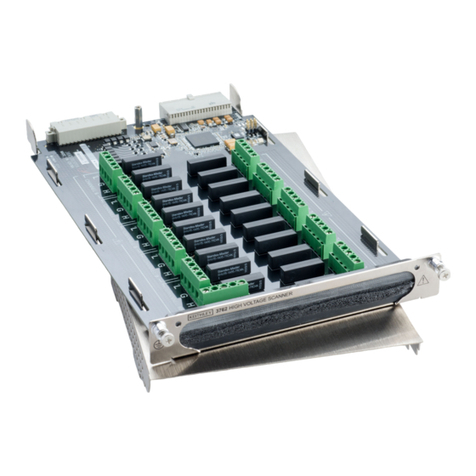
Keithley
Keithley 3706A User manual
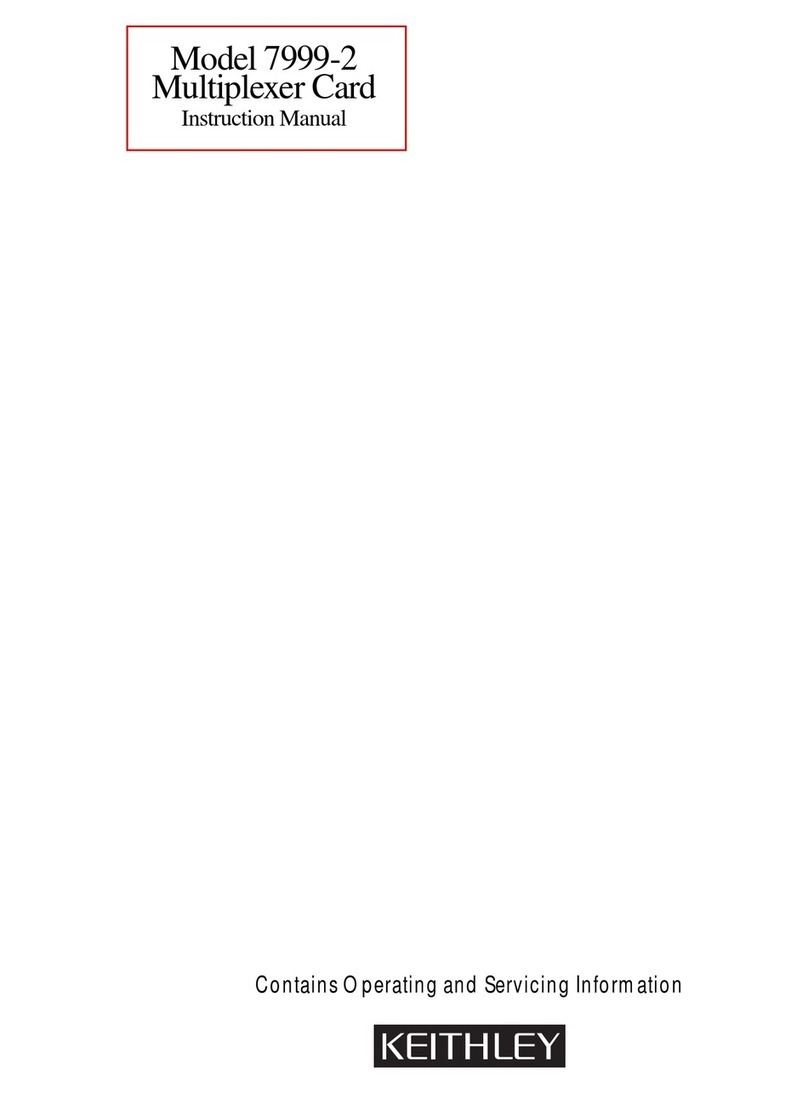
Keithley
Keithley 7999-2 User manual

Keithley
Keithley 7711 User manual
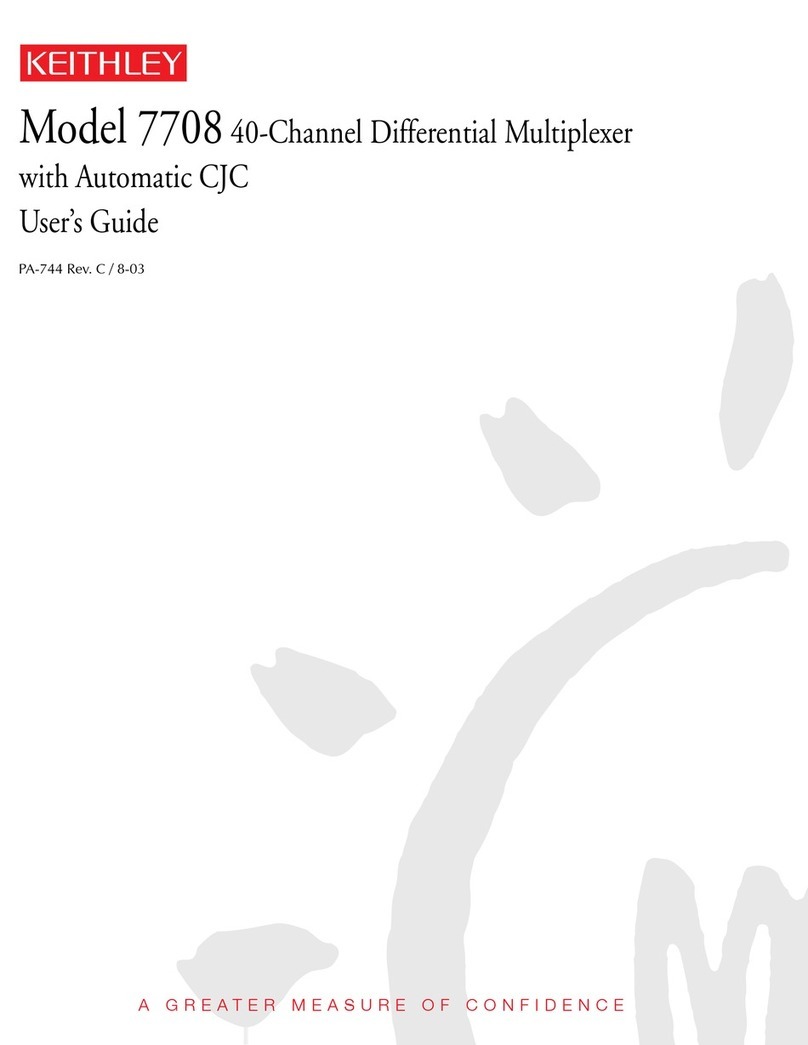
Keithley
Keithley 7708 User manual
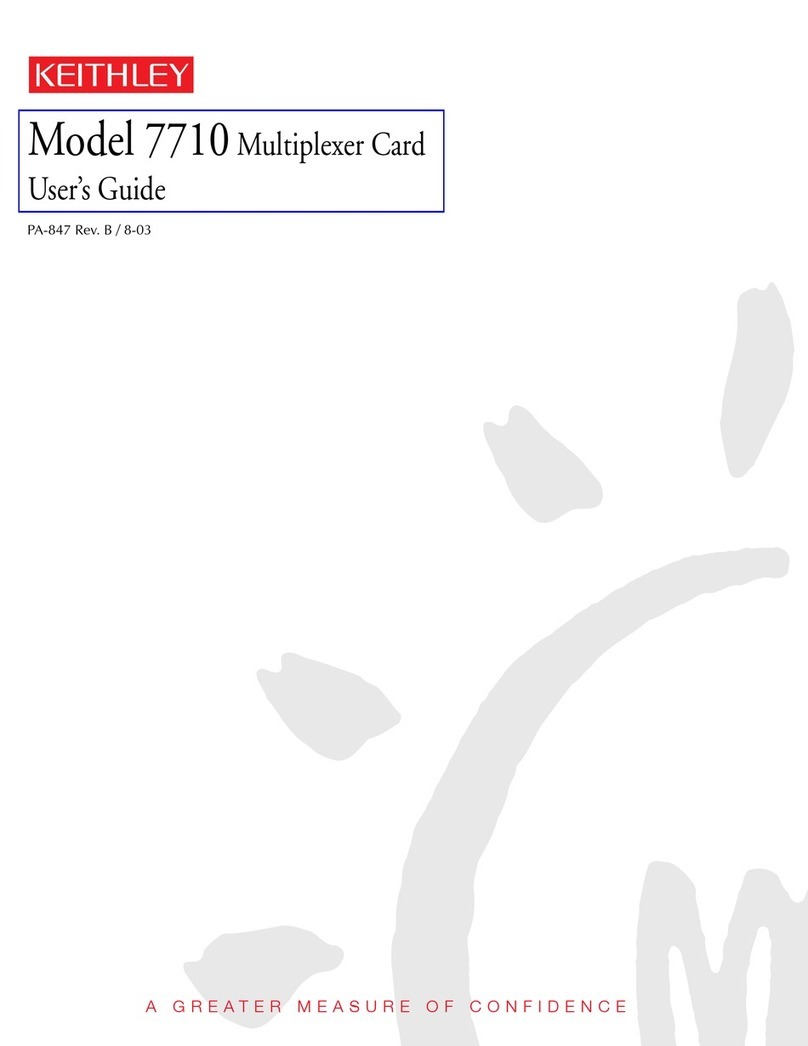
Keithley
Keithley 7710 User manual

Keithley
Keithley 7015-S User manual
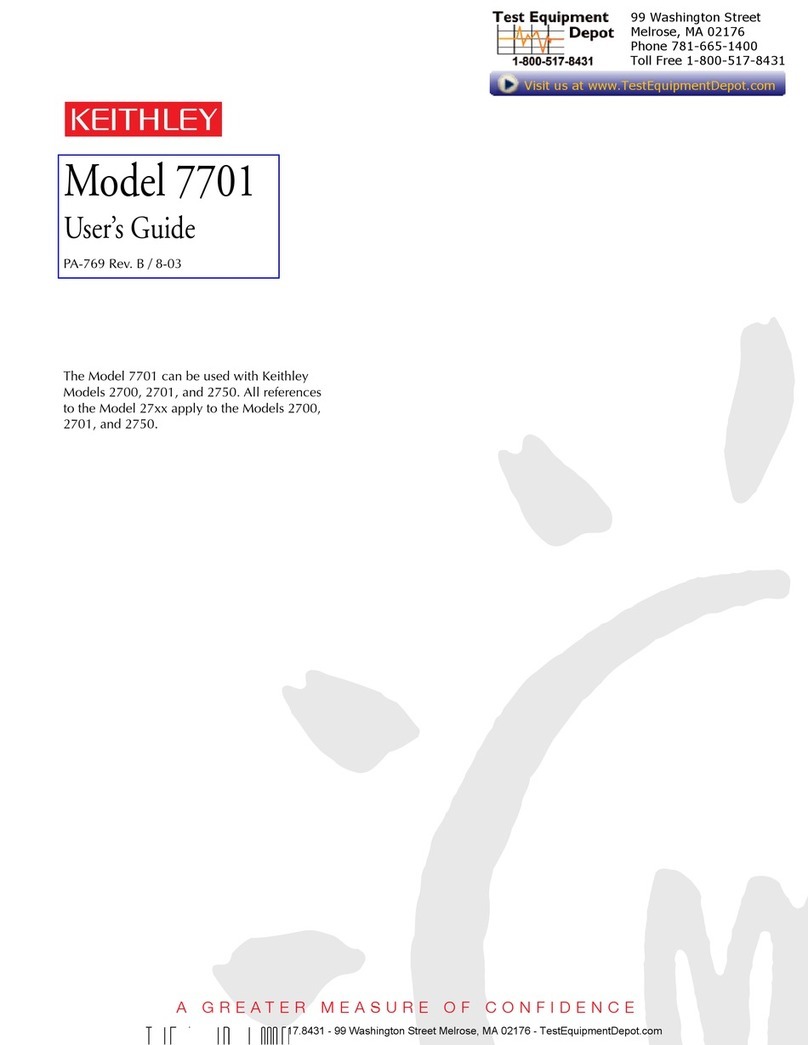
Keithley
Keithley 7701 User manual
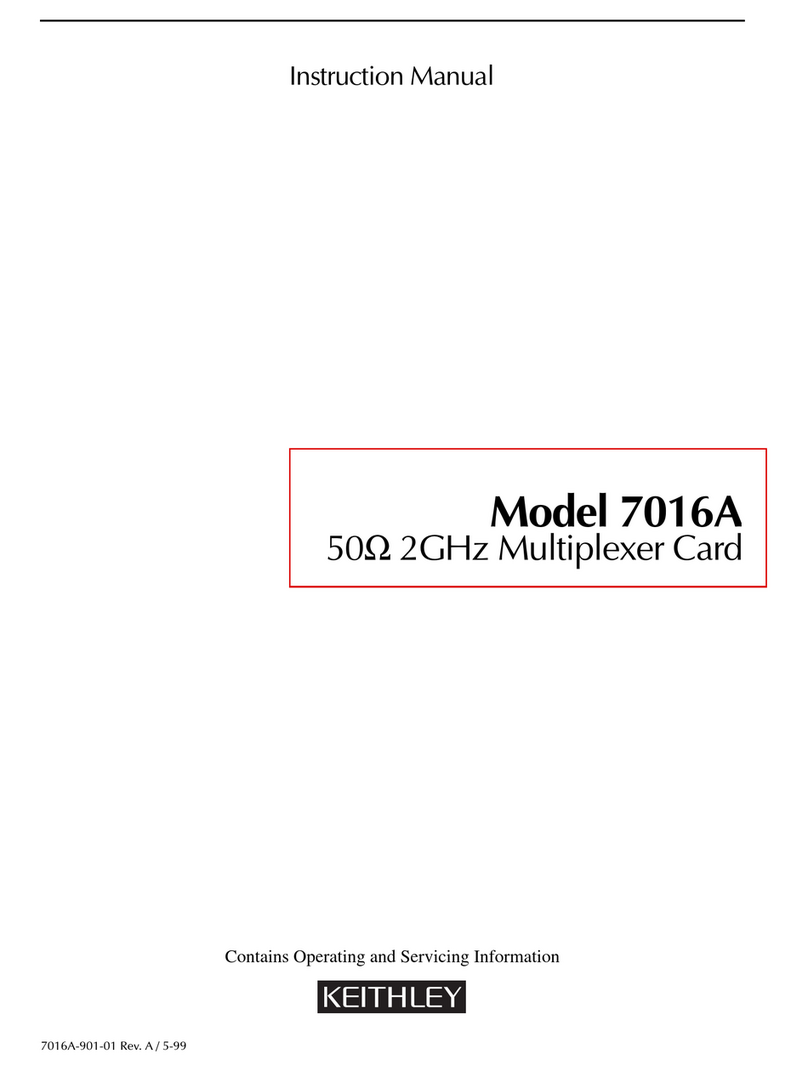
Keithley
Keithley 7016A User manual

Keithley
Keithley EXP-16 User manual

Keithley
Keithley 7014 User manual

